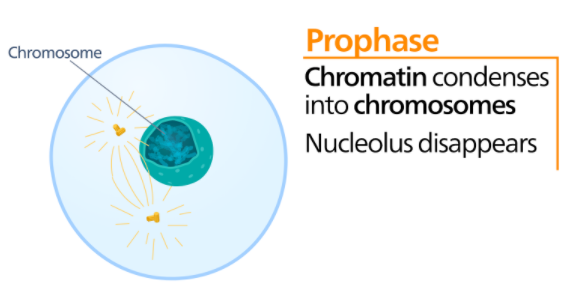
What is known as condensation of chromosomes?
Answer
492k+ views
Hint: A chromosome is defined as a string of DNA wrapped around associated proteins that give the connected nucleic acid bases a structure and it carries a part of genetic information. Chromosome condensation is the reorganisation of chromatin strands into short chromosomes.
Complete answer:
Chromosome condensation basically explained as one of the major chromatin-remodelling events that occur during Prophase I. It is the longest phase of meiosis where;
- Chromatin condenses into chromosomes.
- The physical contact between homologous chromosomes happens
- The transmission of genetic information between synapsed chromosomes.
Here is an outlook of the condensation of chromosomes.

There are five sub-phases under prophase
i) Leptotene: The condensation of chromosomes starts and they attach to the cell membrane through telomeres.
ii) Zygotene: Here pairing of chromosomes starts in this stage and synapsis between homologous chromosomes begin. The paired chromosomes are named bivalents.
iii) Pachytene: Here a chromatid of one pair starts attaching to the chromatid in a homologous chromosome hence the synapse is formed and the crossing over begins. After some time, the crossing over of genetic material between the non-sister chromatids occurs in this phase.
iv) Diplotene: Here, the paired chromosomes separate and become into two pairs of chromatids.
Diakinesis: The chromosomes are highly condensed in this phase. Here the nuclear membrane disintegrates, the nucleolus vanishes and the centrioles move to the equator.
Note: Significance of meiosis is as follows;
- It is responsible for the formation of gametes without which sexual reproduction cannot happen.
- The genetic information for the development of gametes is activated by meiosis and also deactivates the sporophytic information.
- Chromosome numbers are maintained properly by halving the same as the chromosome number doubles after fertilization.
Complete answer:
Chromosome condensation basically explained as one of the major chromatin-remodelling events that occur during Prophase I. It is the longest phase of meiosis where;
- Chromatin condenses into chromosomes.
- The physical contact between homologous chromosomes happens
- The transmission of genetic information between synapsed chromosomes.
Here is an outlook of the condensation of chromosomes.

There are five sub-phases under prophase
i) Leptotene: The condensation of chromosomes starts and they attach to the cell membrane through telomeres.
ii) Zygotene: Here pairing of chromosomes starts in this stage and synapsis between homologous chromosomes begin. The paired chromosomes are named bivalents.
iii) Pachytene: Here a chromatid of one pair starts attaching to the chromatid in a homologous chromosome hence the synapse is formed and the crossing over begins. After some time, the crossing over of genetic material between the non-sister chromatids occurs in this phase.
iv) Diplotene: Here, the paired chromosomes separate and become into two pairs of chromatids.
Diakinesis: The chromosomes are highly condensed in this phase. Here the nuclear membrane disintegrates, the nucleolus vanishes and the centrioles move to the equator.
Note: Significance of meiosis is as follows;
- It is responsible for the formation of gametes without which sexual reproduction cannot happen.
- The genetic information for the development of gametes is activated by meiosis and also deactivates the sporophytic information.
- Chromosome numbers are maintained properly by halving the same as the chromosome number doubles after fertilization.
Recently Updated Pages
Why is there a time difference of about 5 hours between class 10 social science CBSE

Master Class 11 Social Science: Engaging Questions & Answers for Success

Master Class 11 Physics: Engaging Questions & Answers for Success

Master Class 11 Maths: Engaging Questions & Answers for Success

Master Class 11 Economics: Engaging Questions & Answers for Success

Master Class 11 Computer Science: Engaging Questions & Answers for Success

Trending doubts
What is meant by exothermic and endothermic reactions class 11 chemistry CBSE

Which animal has three hearts class 11 biology CBSE

10 examples of friction in our daily life

One Metric ton is equal to kg A 10000 B 1000 C 100 class 11 physics CBSE

1 Quintal is equal to a 110 kg b 10 kg c 100kg d 1000 class 11 physics CBSE

Difference Between Prokaryotic Cells and Eukaryotic Cells




